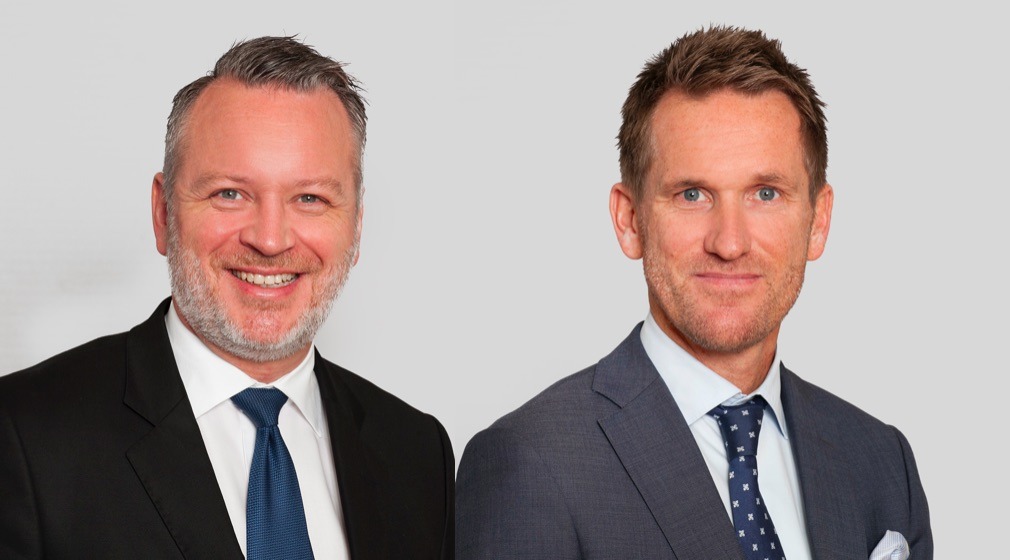By Hamlin Lovell, NordicInvestor
Increased yields on liquid high yield corporate debt are encouraging some investors to revisit the space, but they need to pay careful attention to sector and company selection and liquidity issues. NordicInvestor interviewed Henrik Emil Hoyerholt (pictured top/right), Portfolio manager of Alfred Berg’s Nordic Credits team, who was previously Head of credit research at the Norwegian Oil Fund, NBIM,in London, and Kristoffer Sonnervik (pictured top/left), Director of Institutional Clients.
Alfred Berg, 75% owned by BNP Paribas, manages EUR 20 billion and is the fifth largest asset manager in Norway. It also has a presence in Sweden and Finland. The firm has around EUR 1 billion in Nordic High Yield, including UCITS funds and dedicated mandates from institutional investors in multiple countries, such as Italy, Belgium, Chile and the Czech Republic. The strategy has annualised at 7% in NOK over the past 6 years since Hoyerholt joined.
“Now that investment grade debt yields 5% and high yield offers 10%, direct lending and private debt are relatively less attractive,” argues Sonnervik.
Nordic high yield offers more yield than broader European high yield credit. The additional yield could be as much as 2-3% measured in NOK, though some of this could be given up on hedging back to funds or share classes in lower interest rate currencies. Alfred Berg hedges Euro and USD exposures back to NOK, and keeps about 5% in cash to cover any margin calls. This slightly dilutes returns
“Nordic high yield was once dominated by energy and shipping but has now become a more diversified market including every industry. The high proportion of floating rate bonds is attractive in a rising interest rate climate,” says Hoyerholt, who co-manages the fund with Maria Granlund.
Yet it remains less liquid and less efficient than other high yield markets.
Liquidity alignment
Liquidity is a challenge that can be addressed in various ways. “We seek long term investors, who actually invested more in March 2020, when liquidity was worse than during the GFC,” says Sonnervik.
Technically, swing pricing mechanisms, which vary the bid/offer spread, can help to protect longer term investors from those exiting a fund. “Our high yield strategy normally has a bid/offer spread of around 0.25%, though this was increased to 1% in March 2020,” points out Sonnervik.
He also argues that daily or weekly dealing funds may not always be ideally suited to Nordic high yield. “A closed end fund structure, or one with quarterly redemption terms, could suit some investors. This can allow a fund manager to build bigger positions and take advantage of special opportunities,” says Hoyerholt.
Industry and issuer selection
The higher yields on Nordic credit can be seen as partly an illiquidity premium, but they also represent a credit risk premium. “Short term we could see some more spread widening, but a yield of 60 basis points a month gives some cushion,” says Hoyerholt.
Refinancing debt may not be easy for every issuer. “The primary new issue market is rather on and off so issuers are trying to time it,” he observes.
Careful industry and issuer selection can help to control spread widening risks in a credit bear market. The strategy has made a positive return of 4.5% in NOK in 2022 to August. This was helped by sector selection. “Shipping and energy companies with strong recurring revenues and good earnings visibility have done well. And we have completely avoided Swedish property, which is a big part of the overall Nordic market. Nordic high yield is 45% in Sweden of which 50% is real estate, which means the benchmark weight is 23% in Swedish real estate. We continue to avoid this sector. Central Stockholm property prices have already dropped by 15%, and may fall further”.
Historically, property crashes in Scandinavia have sometimes been associated with banking crises, notably in the early 1990s. This time around, Hoyerholt “does not see any systemic risk, but does expect some individual companies will struggle and may default. Even within a sector such as shipping, there are different sorts of companies and some may prosper while others default”.
The strategy also has less exposure to firms with a B- or CCC credit rating. “They are more risky and may be prone to binary outcomes that could hurt performance,” explains Hoyerholt.
The current climate is one to be cautious about borrowers’ ability to service their debt. Floating rate debt is fine so long as companies can afford the higher costs. Regardless of credit spreads, it is possible that higher interest rates could maintain upwards pressure on overall yields for high yield issuers. “Energy and inflation could stay higher for longer,” says Hoyerholt.
ESG
Alfred Berg’s corporate parent BNP produces sustainability research that covers 90% of the Nordic market, and includes data from ratings agencies such as Sustainalytics and MSCI. A carbon footprint is reported monthly.
“Alfred Berg also has a fossil fuel free ESG high yield fund, which excludes oil, gas and coal but not downstream shipping. It is attracting some interest in Sweden, though most clients are in the traditional fund,” says Sonnervik.
Most Alfred Berg products are making disclosures under SFDR category 8, though their index funds are actually still category 6. This could change in future. “Some clients have expressed an interest in a category 8 index fund,” says Sonnervik.
Beyond the Nordic high yield universe, there is a category 8 index fund for global high yield. Alfred Berg runs a global enhanced index strategy which sets minimums for green, social and sustainability bonds.
Currently, the manager has no credit funds making disclosures under SFDR 9.



